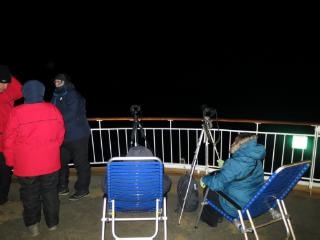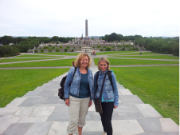News
MAI 2017
New publications
Arild Røkenes and Line Mathisen have published the book chapter: Roles of Adventure Guides in Balancing Perceptions of Risk and Safety, in Arctic Tourism Experience. Production, consumption and sustainability. Eds. Young Sook-Lee, David B. Weaver & Nina K. Prebensen. Cabi International. http://www.cabi.org/bookshop/book/9781780648620
This chapter aims to broaden existing understandings of risk and safety in guided Arctic adventure activities, by exploring the stories of tourists who have participated in guided adventure activities, and their feelings of risk. In particular, it examines how their interactions with guides and environments influence their risk perceptions. The chapter has a customer focus and applies the concept of value co-creation to address this issue. To gain more knowledge about the interplay between risk and safety in the adventure experiences of tourists, this chapter creates a typology of tourists to illustrate how different tourists can experience risk and safety, and how guides influence this interplay.
Kari Jæger and Line Mathisen has published the book chapter: Co-creation in Events: Values of Volunteers and Volunteer Tourists at Iditarod in Alaska and the Finnmark Race in Norway. In International Sport Volunteering, edited by A.M. Benson and N. Wise, (pp. 21-28), Abingdon and New York: Routledge. https://www.routledge.com/International-Sports-Volunteering/Benson-Wise/p/book/9781138697775
This chapter is about volunteer’s value creation in events. Values created through co-creation among volunteer tourists that travel to events and work alongside local volunteers and others involved in the events. The chapter examines value creation for the volunteers themselves, both as a tourist volunteer or a local volunteer, and for the event.
MARS 2017
New publications
Stein Roar Mathisen has published the journal article: Mellom borealisme og orientalisme: Fortellinger og forestillinger om «de andre» i nordlysturismen in Tidsskrift for kulturforskning. http://ojs.novus.no/index.php/TFK/article/view/1379/1364
The article takes as its point of departure a media narrative, relating that Northern Lights tourists from the East are not only visiting the northern areas to experience the celestial phenomenon, as their actual hope is to conceive under the Lights. According to alleged old beliefs in the East, this is supposed to give handsomer, healthier, and more intelligent children. The location of these beliefs in the touristic border zone, and relating it to modern tourism imaginaries and myths, opens new perspectives for the understanding of these narratives. Discussing one possible mediated background for what eventually turns into a migratory legend answers some questions. However, the further development and metamorphosis of the legend, and finally its materializations in the tourism industry opens new perspectives on narrated relations between hosts and guests.
Christian Buschmann Ekeland has published the journal article: High as a kite: exploring the positive emotion of interest through extreme sporting in the arctic. Int. J. Tourism Anthropology, http://www.inderscienceonline.com/doi/abs/10.1504/IJTA.2016.081744
The emotion of interest creates an urge to explore an external world, to become involved and to learn. But as our relationships to objects of interest mature, they also become more important to the self. So is it that we develop lifelong pursuits of academic writing, music or kiting, as ways of finding meaningful happiness. This article explores the pivotal role interest has in the formation of new knowledge; what interest feels like, the agency it has and how it is performed. Expansions are made to contemporary interest theory by underlining the importance of spatiality and places. Furthermore, as an analytic autoethnography, it explores how interest creates powerful place attachment processes and feelings of belonging, which also influences representation. The latter is recognised here by being both analytic and evocative in order to represent interest more nuanced.
FEBRUARY 2017
New publications
Katrín Anna Lund has published the book chapter: Chasing the Lights: Darkness, Tourism and the Northern Lights. In Abram, S. and Lund, K. A. (eds.), Green Ice: Tourism Ecologies in the European High North, pp. 49-71. London: Palgrave Macmillian.
In recent years winter tourism in Iceland has been growing steadily featuring the Northern Lights as an important attraction and since 2009 the Lights have been used intentionally to promote Icelandic winter landscapes. The Lights, however, are mysterious, flickering in their nature and sightings are unreliable due to their different strengths and weather conditions. Moreover, the primary condition for sightings is darkness, which has traditionally in the Western mind been associated with chaos, even danger. This may seem to contradict how Icelandic landscape were composed and created by 18th and 19th Centuries explorers or to be visually approached as pristine and majestic, evoking a sense for the sublime, an image that the contemporary tourism industry continuous to promote. Thus the paradox of the promotion is that Icelandic natural landscapes were created to be seen and appreciated in daylight and not in darkness. In order to explore how the Northern Lights fit in with this natural landscape this chapter explores how the Northern lights are promoted and simultaneously experienced by tourists, which reveals how darkness is constantly being improvised, ordered and managed by different actors, making it inviting by bringing out its sublime qualities.
Gunnar Thór Jóhannesson and Katrín Anna Lund have published the article Aurora Borealis: Choreographies of darkness and light in Annals of Tourism Research. http://www.sciencedirect.com/science/article/pii/S0160738317300257
This paper explores some of the ways in which Northern Lights tourism is composed and performed. In particular, we will focus on the interplay between light and darkness and how tourists, tour operators and various more-than-human elements are engaged in and contribute to affective lightscapes of Northern Lights tourism through improvised choreography. The discussion is based on an ethnographic example from one Northern Lights tour. The paper advances understanding of the importance of how bodies and rhythms intertwine with the surroundings creating tourism experiences as well as contributing to the affective field of destinations.
JANUARY 2017
New publication
Bente Heimtun and Brent Lovelock have published the article Communicating Paradox: Uncertainty and the Northern Lights in Tourism Management. http://www.sciencedirect.com/science/article/pii/S0261517717300183
While many characteristics of tourism products are well known, relatively little work has explored elements of uncertainty and risk. Little is known about how tourism operators communicate aspects of uncertainty. This qualitative study uses content analysis to explore the language used in promotional material of tour operators and destination management organisations to communicate the unpredictable nature of northern lights. The study involves two Norwegian destinations (2004–2014). Three rhetorical strategies are identified: first, the rhetoric of technology, enhanced mobility, and adding additional activities; secondly, through ‘hiding’ or obscuring the uncertainty; and thirdly, through employing culturally and geographically appropriate metaphors (i.e. ‘hunt’) to embrace the element of uncertainty. This study advances our understanding of how tourism operators rhetorically address temporally and/or spatially uncertain attractions by demonstrating how the operators negotiate and minimise uncertainty through the narrative of ‘the hunt’. This rhetoric implies that uncertainty can enhance value in a touristic experience.
DECEMBER 2016
New publication
Bente Heimtun has publised the article.Emotions and Affects at Work on Northern Lights Tours in the journal Hospitality and Society. http://www.intellectbooks.co.uk/journals/view-Article,id=22846/
In this article she explores the complexities of emotions and affects imbuing Northern Lights tourism and how this informs the host/guest transactions performed in this context. She does this by focusing on how Northern Lights tour guides – through emotional labour and hospitality – engage with tourists’ emotional expectations and experiences and an atmospheric landscape comprising discursive imaginings of the lights, the elusive and unpredictable aurora, darkness, weather and the arctic landscapes. Data were collected through interviews with both guides and tourists, through written documents (TripAdvisor) and through fieldwork. The findings demonstrated that the guides enacted emotional labour in six, partly overlapping, ways: stepping back, knowledge and expectation clarification, the hunt, entertainment, hostessing and unawareness. They also showed that, regardless of sightings, most tourists were satisfied with their tours. Only a few tourists were really discontented, not because of no-show, but because of the guide’s inability to cater to their different needs in a dark and cold environment.
Master thesis:
Sense of Svalbard A study of place attachment through winter recreation on Svalbard. Alta: UiT the Arctic University of Norway, by Dora Bimbo Aamot. Thesis Dora Bimbo Aamot
Even though Svalbard has been pronounced as “no place for humans”, primarily because of its location, climate and remote appearance, it has been recognized several times in books and articles. As a consequence, tourism in the archipelago started about 100 years ago. The biggest increase in tourism occurred during the last 25 years, due to technological advances and to symbiotic co-operation between the tourism industry, researchers and governing bodies. Today, during both summer and winter, it attracts visitors from all continents.
 Photo: Dora B. Aamot - Svalbard
Photo: Dora B. Aamot - SvalbardFrom the moment we are born, we seek safety, comfort and satisfaction. Then during the first months of our life, the longing and need for attachment begins and continues throughout our lifetimes. This emotional bond connects us with others through time and space. It can be directed not only towards humans but towards animals, objects and places as well. A physical place can appear as a special place—a place to practice and concentrate on hobbies; a place to be together with others; and a place, which reflects who we really are—a place for personal growth. The term “sense of place” describes the characteristics, which make a place unique and special, and evoke belonging and attachment needs.
This Master’s research was conducted in Longyearbyen using a quantitative survey to reveal and understand the interaction between place attachment and tourist experience during winter recreation in Svalbard. The research aim was to provide a holistic representation of the relationships between human and environment, and uncover factors, which can make the winter tourism of Svalbard meaningful enough to arouse positive attachment. The thesis also describes how personal experiences and physical, emotional and social aspects can affect a person’s relation to places.
 Photo: Dora B. Aamot - Dogsledding Svalbard
Photo: Dora B. Aamot - Dogsledding SvalbardOCTOBER 2016
New publication
Outi Rantala, Arild Røkenes and Jarno Valkonen have published the article: Is adventure tourism a coherent concept? A review of research approaches on adventure tourism in Annals of Leisure Research. http://dx.doi.org/10.1080/11745398.2016.1250647
This paper explores the boundaries between adventurous activities and tourism are blurring as evidenced in the diffuse usage of concepts, such as, wilderness, safari, nature guiding, adventurous and adventure with regard to tourism. This blurring is also reflected in research associated with adventure tourism. In our paper, we ask, how is adventure tourism defined and categorized in tourism and associated literature? Our study involved a literature review, including development of a systematic methodology for creating a comprehensive list of articles. The first amount of references that resulted from the literature review totalled 2119. This number highlights that adventure tourism has been widely studied. However, those studies have been dispersed among different disciplines and journals. Based on our literature review, we argue that the term ‘adventure tourism’ as used in tourism research is more like a category than an analytical concept. Hence, we conclude that a reconceptualization of adventure tourism is required.
SEPTEMBER 2016
New publication
Christian Ekeland and Tove Dahl have published 'Hunting the light in the high Arctic. A triangulation study of interest development among English tourists on board the coastal steamer Hurtigruten', in Tourism Culture & Communications. http://www.ingentaconnect.com/contentone/cog/tcc/2016/00000016/F0020001/art00003
This article explores the dynamics of interest as an emotion-related component of the tourism experience. The research site was the Norwegian coastal steamer Hurtigruten and the subjects were English visitors "hunting the northern light." The latter experience has become a pillar of regional tourism development over the Arctic winter. The effectiveness of Hurtigruten in attempting to trigger and sustain interest is measured through the use of questionnaires, observations, and interviews. There were two main findings. First, existing theory is extended through the characterization of interest as a form of "wanting schismogenesis," which occurs in the absence of the object of interest, namely the northern lights. Second, the use of triangulation has highlighted the importance of distinguishing between the "remembering self" and the "experiencing self" in the study of emotions. By combining observations, which capture representations of the experiencing self, with interviews and questionnaires, which capture representations of the remembering self, and deviations between these phenomena, the researchers offer a new perspective on the study of emotions in the tourism context.
JUNE 2016
Master thesis:
Safe adventures: An ethnographic study of safety and adventure guides in Arctic Norway, by Mats Hoel Johannessen Thesis Mats Hoel Johannessen
I have since 2012 been involved in adventure tourism in Arctic Norway as a student, guide and entrepreneur. As an educated Arctic Nature guide the topic of safety has always been of a great personal interest. However, the idea behind the thesis started to develop when I noticed that such questions was repeatedly debated in national media. Based on my background, it felt natural to explore this topic from the perspective of guides. My data in the thesis are derived from autoethnographical diary, as well as interviews with six domestic and international guides in Arctic Norway.
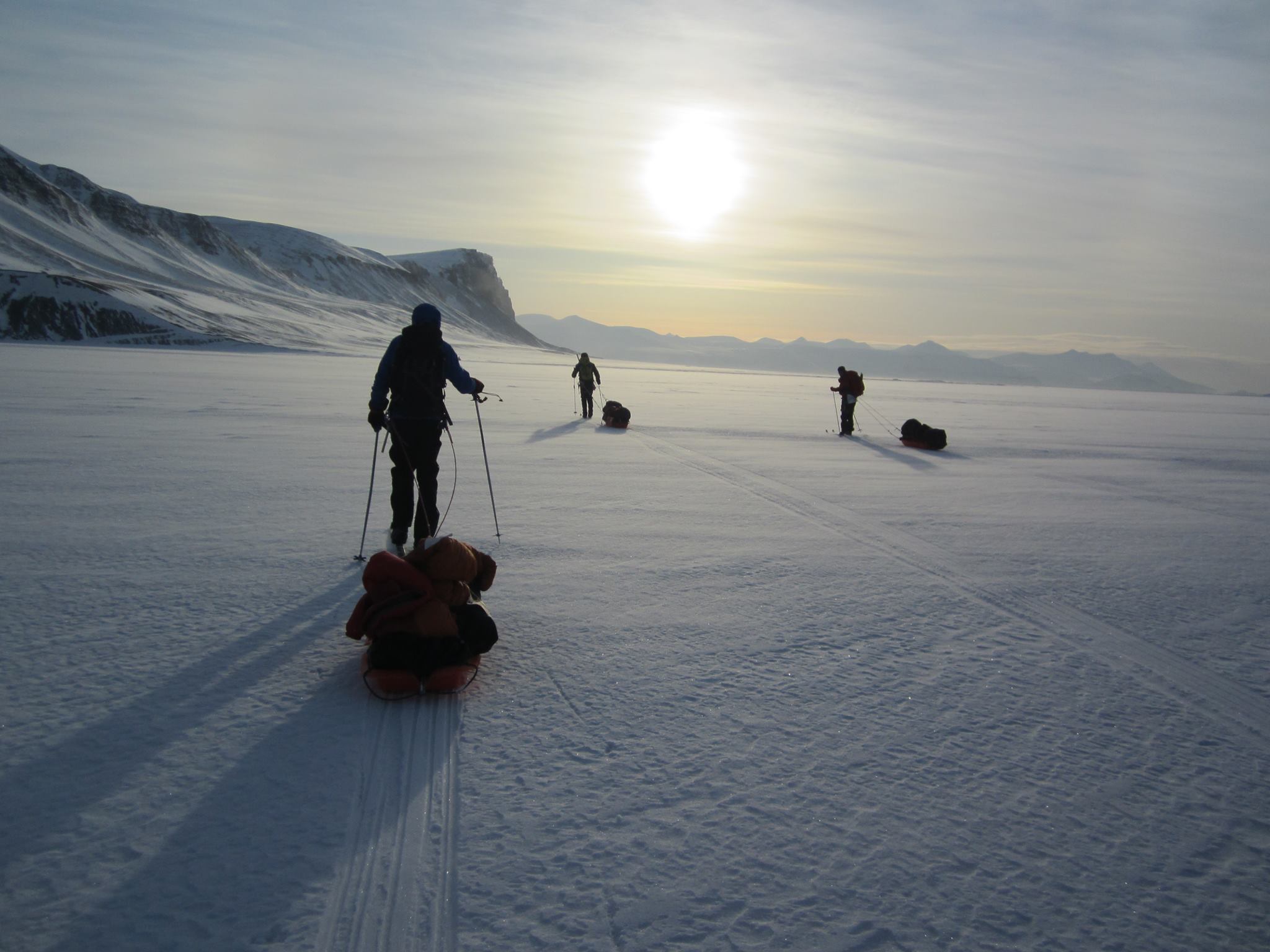
© Eirik Grini
The content analysis resulted in a thesis with a slightly different direction than I assumed at the beginning. Surprisingly, the guides, instead of talking about specific elements within the topic of safety, voiced issues concerning the work and quality of work in Arctic Norway. For instance, that their working conditions were dependent upon the company, and even the products that they guided. At the same time, similar to other places, guides in the Arctic also worked seasons, and often did physically tough work with much responsibility. Moreover, the guides often had fluctuating working hours, meaning that they often worked either more or less than the standardized 7,5 hour day. This had impact on family circumstances. It was also common that the guides worked without being paid (e.g. preparations). This extra work, on top of the regular working hours, often made the guides stressed, which then potentially jeopardized issues concerning safety. Further, it was also evident that the working environments and working cultures varied a lot from company to company. Such variations were the result of the almost lack of governmental regulations of adventure tourism companies.
In the thesis I also argue that safety and other relevant practices must be understood through the intersection of friluftsliv and adventure tourism. Operators within the industry use their own friluftsliv experience and interests when creating adventure tourism products. In combination with few governmental restrictions, this opens up for a highly individualistic approach towards how to take preventive actions and how to solve issues concerning safety. The same individuality also marks the products, as guides are given few guidelines. Consequently, it is mostly up to the guide to utilize their own friluftsliv skills in order to execute the product in a safe manner. Guides criticize these loose guidelines. First, they feel that there are too little restrictions in respect of hosting, and producing adventure tourism products in both Arctic Norway, and in the country in general. This is exemplified in that all training is based on the company owner’s friluftsliv experiences. Hence, the lack of a systematic approach towards safety jeopardizes such issues. Second, guides became less stressed when working within a systematic approach, and standardized routine. A more systematic approach towards safety is therefore my recommendation to the industry.
APRIL 2016
New publication
Kari Jæger and Kjell Olsen have published the journal article On commodification: Volunteer experiences in festivals in Journal of Tourism and Cultural Change. http://www.tandfonline.com/doi/abs/10.1080/14766825.2016.1168827
This paper is about the creation of non-commodified volunteer experiences, for tourists and local volunteers participating in festivals. How is the tourist experience created when most of the traditional tourism demands are not fulfilled? And what are the experiences and how do they relate to different ‘regimes of value’? The experience context includes tourists who work together with locals voluntarily in a festival, where the volunteers pay for their own travel, food, overnight stay, and work for free. To gain more knowledge on the volunteers is important because local cultural life becomes more festivalized, most festivals are reliant on the involvement of volunteers, and the festivals gain an important role in an economy where even small places are engaged in branding [Löfgren, O. 2003. The new economy: A cultural history. Global Networks, 3, 239–254]. This paper uses a qualitative approach. Interviews were conducted (n = 23) and participants were observed during four festivals in Finnmark, Norway. Nothing in the experiences was facilitated, and the experience creation occurred in the work tasks together with volunteer colleagues. It was like a holiday experience, without a stream of commodified moments. It was a value creation that could be seen as authentic and real, created in the interaction between the local and visiting volunteers.
DECEMBER 2015
New publications
Brynhild Granås has published the book chapter: Fra stedsteori til teori om sammenkastethet. Materialitet, historie og geografi i lesninger av hundekjøring i Norge, In Aure. M, Gunnerud Berg, N., Cruickshank, J. og Dale, B. (red.) Med sans for sted. Nyere teorier. Bergen: Fagbokforlaget. https://fagbokforlaget.no/?isbn=9788245017779
The author dicusses what dogsledding becomes and what it does in a Norwegian context. Year by year, dogsledding is increasingly involved in constitutions and reconstitutions of many towns, villages and landscapes, in material as well as in semiotic terms. In this article, many such examples of place effects will be described along with others, in an analysis of meaning making and identity formations in long-distance dogsledding in Norway. Theoretically, the article suggests how Doreen Massey’s theory of place (Massey, 1994; 2005; 2006; 2007) can be transformed and developed further into a theory of throwntogetherness (Massey, 2005, p. 40-142). Such an adjusted theoretical perspective can prepare for geographically, historically and materially reflexive analysis of cultural processes, also when the place is not the point of departure or study object. As part of this, and while relying on the work of Donna Haraway (1991; 2003; 2008), the article demonstrates ways of operationalizing Massey’s theoretical universe and suggests for how to specify it and develop it further when it comes to that of handling materiality and history.
Bente Heimtun and Arvid Viken have written the book chapter: Nordlysturismen – en institusjonelt betinget utvikling? In A. Viken (ed.) Turisme. Destinasjonsutvikling, 175-197. Oslo: Gyldendal. http://www.gyldendal.no/Faglitteratur/OEkonomi-og-administrasjon/Reiseliv/Turisme6
The authors dicuss the development of Northern Lights tourism through three case studies: Alta, Tromsø and Hurtigruten. Although there have been various development scenarios and successes, there have been product-generating processes with mutual knowledge accumulation both in Alta, Tromsø and Hurtigruten. We therefore see the outlines of what has been called industrial district or learning regions related to Aurora tourism. One aspect of such local or regional materializations is that they have a certain duration, and contains elements of culture and tradition. Tradition is a form of path dependency which is often a resource, but may also represent lock-ins. Tromsø has a long tradition as place for tourism, with service industries and a large hotel and nightlife industry. These traditions have been a resource for the city. In Alta it has been the other way. As a town Alta has a short history, the tourism industry is small, and its agenda have mostly focused on industrial and agricultural industries. Tourism in Alta has meant an exclusive lock-in - only a few and small actors were ready to continue the development of Northern Lights tourism that was created through Finnmark Reiseliv’s winter project. Small scale businesses are more challenged when it comes to gaining industry and learning effects. Tromsø has had a larger industry and a positive buzz around activities, and Hurtigruten is a large organization. Relationships have in both Alta and Tromsø created cooperative climate and contradictions, both in regards of competence development and conspiracy. The outcome of these tensions have been tendentially positive in Tromsø and negative in Alta. Hurtigruten, as a single company, has avoided unfortunate relationships. The company has managed to turn upside down on its business culture.
SEPTEMBER 2015
Four new publications
Arild Røkenes and Sigmund Anderson have written the book chapter: The Arctic Nature guide Program at 78 North. In E. Rosemary Black and K. Bricker (eds.) Adventure Programming and Travel for the 21th centry. https://www.venturepublish.com/product.php?id=188
This book focuses on Adventure education within recreational, educational developmental and therapeutic programming. Røkenes and Andersens contribution describes the Arctic Nature Guide program on Svalbard. It discusses the need for multidisciplinary competence from both friluftsliv, tourism, marketing and natural science to succeed in educating nature guides prepared for positions in a sustainable tourism industry.
Bente Heimtun has published: Tourists’ Affective Perceptions of a Cold Destination: Feelings Towards Northern Norway in the Winter, in The Northern Review:
This article examines potential tourists’ interest in Northern Norway as a Subarctic winter destination. Specifically, it explores seasonal destination image constraints and drivers among national and international tourists visiting Norway in the summer. The aim was to qualitatively explore these tourists’ feelings towards the winter climate, winter landscapes, winter activities, and winter attractions. The study identified three affective images. First, among the “winter people,” the climatic conditions and opportunities evoked positive feelings towards the northern lights, coldness, darkness, snow, and remoteness. Second, the “summer people” reacted negatively towards Subarctic winter landscapes, which they found too cold, too dark, and too dangerous for travel. Third, the “ambivalent people” were both pleased and aroused by winter; at the same time, cold and darkness were not as exciting. These findings revealed that seasonality shapes affective destination images and that several perceptions of a tourist destination co-exist. http://journals.sfu.ca/nr/index.php/nr/article/view/463
Arild Røkenes, Scott Schumann and Jeff Rose have publised: The Art of Guiding in Nature-Based Adventure Tourism – How Guides Can Create Client Value and Positive Experiences on Mountain Bike and Backcountry Ski Tours, in Scandinavian Journal of Hospitality and Tourism:
This paper examines the ways in which guides contribute to creating value to clients. The context is nature-based adventure tourism in the specific mediums of mountain bike and backcountry ski tours in Utah and Idaho, USA. Qualitative interviews of clients and guides combined with participant observations are used to explore how guides interact with clients to increase their perceived value. Important findings are related to how guides use their knowledge about the activity, the area, safety management, as well as their organizational skills, to effectively and conveniently facilitate fun experiences with minimum risk exposure. The paper also documents guides’ contributions related to learning, relational aspects, entertainment techniques, and providing information about environmentally friendly behavior. An important theoretical contribution is the identification of how guides carefully balance thrilling and safe experiences and avoid experiences that cause anxiety. The study documents how guides can contribute to prevent negative incidents like conflicts within the client group, or possible accidents. The study indicates that there is a potential for increased contributions from guides especially related to choreographing experiences, interpreting nature, and learning of behaving environmentally. http://www.tandfonline.com/doi/abs/10.1080/15022250.2015.1061733
Torill Nyseth and Arvid Viken have published: Communities of practice in the management of an Arctic environment: monitoring knowledge as complementary to scientific knowledge and the precautionary principle? in Polar Record:
This article addresses knowledge management in governing vulnerable polar areas and tourism. Since the 1870s, Svalbard has been a cruise tourism destination. Due to less ice during the summer period, the number of tourists visiting the remote northeast corner of the archipelago has increased significantly, and the potential negative impact on this vulnerable natural environment has become an issue. The standard modes of managing these areas have either been to apply the precautionary principle or measures based on scientific evidence. As management models, however, both principles are contested for a number of reasons. This paper argues for a third model that is partly based on a form of monitoring knowledge that has circulated in ‘communities of practice’ and that has been developed over time. This form of knowledge constitutes viable expertise for the governing and management of the environment-tourism nexus in the area, but it needs to be acknowledged as a complementary management platform. This article demonstrates how such monitoring can be done, and it suggests some principles for the development of monitoring knowledge for administrative and management purposes. http://journals.cambridge.org/action/displayAbstract?fromPage=online&aid=9749265
JULY 2015
Master thesis: Tourists performing the unpredictable: The influence of the script, stage and social interaction on Northern lights activities in Northern Norway, by Franziska Wentzlaff Master thesis Franziska Wentzlaff
Visitors travel from all over the world to Northern Norway to view the natural spectacle, the Aurora Borealis or Northern Lights during the wintertime. To increase the chances of visitors viewing the lights, they participate in a range of different activities. In order to get an understanding of how tourists perform during those activities, an ethnographic methodology informed by feministic research values was applied. Data were gathered from different ethnographic methods and thematic analysis was used to categorize gathered data into the script, stage and sharing of performances. The findings indicate that northern light experiences are a fluent process of confrontation, adjustment and improvisation.
The script behind Northern Lights experiences enables the participants to perform unknown activities in unfamiliar environments. Often, performance is a process of fluidly transiting from initially perceived uncontrolled situations to the actual performance of the activity. The uncertainty of the phenomenon Aurora Borealis requires improvisation and flexibility from all involved participants. Activities that are attached to such a place and setting associate with a need for increased improvisation, while flexible activities require additional guidance and structure.
The stage for performance consists of the arctic landscape and darkness both involving uncontrollable factors of the natural phenomena Northern Lights and the weather. Businesses use and form through materiality that supports performance, a controlled environment and stage within nature. The guide negotiates between stage, script and the visitors to enable their performance.
Nevertheless, performance is individual and varies due to personal background and previous experiences. Sharing the experience with others and expressing themselves was almost as important for the tourists as to listen to the guide. Relatedly, performance does not just take place throughout a Northern Lights activity itself, additional performances reach and continue through social media.
MAY 2015
Professor Gunnar Knapp meets King Harld and Rector Anne Husebekk and informs about the Winter project
Below you can read an excerpts of his speak which took place at the University of Alaska Anchorage, May 27:
Good afternoon. My name is Gunnar Knapp. I am Director of the University of Alaska Anchorage Institute of Social and Economic Research. I and three other UAA faculty are honored by the opportunity to tell you about some of the cooperation between UAA and the University of Tromsö which is already occurring. We are very pleased at the opportunities the signing of the agreement today will offer to expand this cooperation.
The range of our cooperation--as reflected in faculty and student exchanges and cooperative research projects, reflects the many things we have in common. We live in similar northern environments, in two of the most beautiful regions of the world. We live, work and play in similar ways. Our economies depend on similar resources, particularly oil and fisheries. Our remote northern communities face similar economic and social challenges. Our aboriginal peoples face similar challenges and have similar aspirations. We have a common Arctic neighbor with whom we need and try to cooperate. All of these things we have in common make understanding and learning from each other's experience both interesting and valuable. Put simply--it is natural--it makes sense--for us to cooperate across a wide spectrum of activities.
…
A second area in which I have interacted with University of Tromsö faculty has been tourism. Three years ago I was invited by researchers of the Department of Tourism and Northern Studies to participate in a research project sponsored by the Norwegian Research Council called the “Winter” project. This is an international research project studying many aspects of winter tourism in the north. I have been working with these researchers on a comparison of the Iditarod and Finnmarkslöppet sled-dog races, and their wide-ranging economic and social implications for Alaska and Finnmark. I have hosted two faculty researchers here in Alaska, as well as a master's student from Alta who wrote her thesis about tourists who visit Alaska to watch the Iditarod. I have found this project extremely interesting and helpful for my own understanding of winter tourism in Alaska as well as the role of events such as the Iditarod in how we who live in the north think about ourselves and how others see us. We have learned that these events which were started by dog mushers because of their love for their sport have gained significant economic importance, and play a major and positive role in attracting not only winter visitors but also summer visitors to our regions.
I should also confess that part of my motivation for participating in this project comparing these two great sled dog races is my interest in a question of great interest and importance to many Alaskans: how did the Norwegian dog mushers get so good? We definitely notice when they come and win our Iditarod! Perhaps the answer is similar to that other even more interesting and important question: how did the Norwegian cross-country skiers get so good?
So in closing, I feel very lucky to have had many opportunities to travel to Tromsö and Alta, to get to know and learn from University of Tromsö faculty and students, to marvel at the beautiful architecture of your Fishery Science building and the beauty of the university setting. It has been professionally stimulating—and it has been fun. I am delighted that, as a result of the agreement to be signed here today, more faculty and students from both Anchorage and Tromsö will have the opportunity to enjoy the kinds of experiences which have been so professionally and personally enriching for me.
NOVEMBER 2014
New report: Northern Lights Tourism in Iceland, Norway and Finland
Authors:
Bente Heimtun, UiT,
Gunnar Þór Jóhannesson, University of Iceland
Seija Tuulentie, METLA
This report is the result of fieldwork in Iceland, Northern Norway and Finnish Lapland, undertaken by tourism researchers from the three countries in 2014. During the last decade Northern Lights tourism has boomed in the case study areas. Important destinations for Aurora tourism are: Reykjavik and Akureyri in Iceland, Tromsø and Alta in Norway, and Rovaniemi and the region around Muonio in Finland. A common feature of this type of tourism is the increased interest from international tourists, mainly from Europe, Northern America and Asia. Moreover, these tourists travel to both large scale and small scale destinations. In common are also the development of mass tourism in the bigger cities, in regards of the number of tour providers and number of tourists, and a more moderate development in the smaller cities. In spite of commonalities several factors also separate the tours and destinations. The Norwegian Northern Lights tours, for instance, tend to be more expensive and they often last longer. In Finland most of the tours are in combination with other outdoor activities and mass tourism is the most noticeable in Reykjavik. Thus, there the tours are the cheapest. Furthermore, in Iceland and Alta mostly local guides are employed, whereas in Finnish Lapland and Tromsø many workers are from other Europeans countries.
Here you can read more: Report 2014.pdf
SEPTEMBER 2014
Master thesis: The different types of tourists and their motives when visiting Alaska during the Iditarod, by Paulien Becker thesis Paulien Becker.pdf
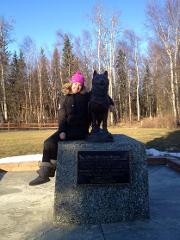 |
| Paulien with Balto (© Paulien Becker) |
This MA research investigates the different types of tourists and their motives while visiting Alaska during the Iditarod. I followed part of the Iditarod 2014 during my half-year stay in Alaska. Understanding the tourists and their motivations is important for understanding travellers’ behaviours, predicting future travel patterns and in helping tourism industries to develop effective marketing programs to attract the travellers.
For this master thesis, mixed methods were employed. Three in-depth interviews were conducted with different tour operators based in Anchorage and Nome, offering tours during the Iditarod. A survey of 56 tourists was done on five locations before, during and after the race. This survey demonstrated that an international sport event such as the Iditarod is attracting several types of tourists. 1) For ‘the casual visitors’ the Iditarod played a limited role in their decision to visit Alaska. Once they were in Alaska, they decided to participate in some activities like the start of the race in downtown Anchorage. 2) For ‘the eye-opening visitors’ the Iditarod also played a limited role in their travel decision, but once they arrived, they wanted to participate in the Iditarod activities. Then they got extremely interested and ended up having a deep and new experience. 3) The ‘bucket list visitors’ dreamt for a long time about travelling to Alaska to witness the Iditarod. They sought a deep cultural experience. 4). The ‘experienced visitors’ had a history with the Iditarod and had made repeated visits. Some of them volunteer, whereas others just followed the race and supported the teams along the trail. The experienced visitors knew how the race worked and was used to the atmosphere.
A sport event like the Iditarod involves sport, cultural aspects, and adventure. It is organized in a way that attracts spectators from all over the world even tough the logistics are difficult. Besides that, the Iditarod is having the effect that it keeps locals at home and it motivates visitors, who are already in Alaska, to stay longer. The Iditarod is having a large tourism value regarding out of state visitors. The Iditarod race is taking care of a positive destination image worldwide because of the cultural aspects involved.
AUGUST 2014
Master thesis: The Northern Lights Experience - Negotiation strategies
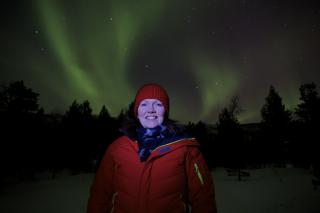 |
| Nina Smedseng under the Northern lights (© Nina Smedseng) |
The idea for the thesis immerged through my employment at Northern Norway Tourist Board. Here, the marketing of northern lights is a very important part of winter activities in Northern Norway. For me personally, the intriguing part is the illusiveness of this ever changing celestial phenomenon, and how this affects tour providers in their staging and narrations. I therefore did a descriptive analysis of different northern lights experiences in Alta (Thesis Nina Smedseng).
The research questions were:
- What are the key elements of the Northern Lights experience?
- How is the Northern Lights experience staged and narrated, and how do the providers negotiate natural conditions and constraints?
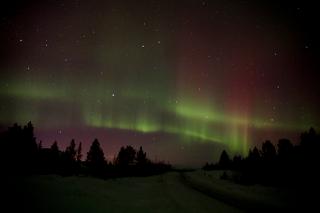 |
| Northern lights (© Nina Smedseng) |
The data collection demonstrated that designing Northern Lights experiences is challenging when spotting the main attraction, the Aurora Borealis, cannot be guaranteed, and that no-shows have to be dealt with. However, although nature is the ‘maker’ of Northern Lights, the experience providers still have a certain influence of this kind of nature based experience in the sense that they can negotiate the unruly forces of nature. This is done through negotiation strategies; for instance, they use certain staging and narrative elements in order to handle no-shows. In the absence of the Northern Lights, the structure of the experience and the narratives become more important, especially in ‘hunting the lights’-tours which only are about finding clear sky. Moreover, as the weather can change fast, flexibility within staging and narrating is called for. A dynamical system is thus necessary in order to adjusted to the natural conditions. For successful Northern Lights experience, flexibility is thus a prerequisite.
Nina Smedseng, Alta, 27. 08.2014
JULY 2014
Master thesis: Actor-Networks of Northern Lights tourism in Iceland, Norway and Finland
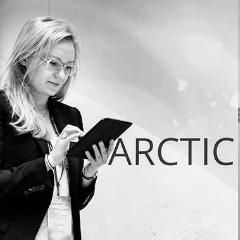 |
| Researcher at work. (©Tiina Kivelä) |
In the Finnish Lapland, where I come from and where I still live in, the midnight sun is up and it will not set before 12th of July. Nevertheless, my thoughts are still regularly wandering in the darkness of last winter, when I took part in the data collection of the Winter project, as a Master’s degree student at the University of Lapland. In my Master’s thesis I studied the Actor-Networks of which, and by which, Northern Lights tourism products are produced in Iceland, Norway and Finland. The thesis and my findings can be read online. Link to Master thesis Tiina Kivelä
In my thesis I identified the Actor-Networks of Northern lights tourism in the Arctic regions of Iceland, Northern Finland and Northern Norway. Using an ethnographic methodology I studied how the Northern Lights tourism products and practices are produced, performed and consumed in collaboration and in relationships between human and non-human actors. My findings create a picture of Northern Lights tourism as a fluid, ever-changing network of actors, which by materialising social and natural objects creates a tourism field which has the possibility to gain collaborative advantage in providing nature-based experiences and products for supply and consumerism. The most notable actors include guides, tourists, weather, time, darkness and technology. In my thesis I argue that by taking into account the subjectivity of human and non-human actors in Northern Lights tourism context the practitioners are better prepared for answering to the growing needs of Northern Lights tourism, which will be of relevance to them and to the wider future tourism development in the Arctic.
| Northern Lights are everywhere. At least on paper. (© Tiinia Kivelä) |
For me being part of this research group and project was a challenging but rewarding learning experience. Therefore I want to thank Bente Heimtun, Nigel Morgan, Gunnar T. Jóhannesson, Katrin Anna Lund and Seija Tuulentie for the company, for organising and managing the fieldwork and teaching me how great of an experience it is to be an researcher on the field and to be part of an inspiring and supporting international research group.
| Akureyri looks nice even with the artificial lights. (© Tiina Kivelä) |
Most importantly, during this process I learned that when nothing is certain everything is possible. You will see the lights when you have enough patience and when you have the courage to step out of your comfort zone. Even though I managed to see the Lights during some of the trips in all of the three countries, it was not before I had returned home and started analysing the data that I one evening managed to capture the Northern Lights with my camera, from my own balcony in Rovaniemi.
| Northern Lights above Rovaniemi. (© Tiina Kivelä) |
Sometimes it is just about being on the right place to the right time. Or if you are lucky enough like I am, to live in that place called Arctic.
Tiina Kivelä, Rovaniemi, 26.06.2014
March 2014
Tourists in the Dark
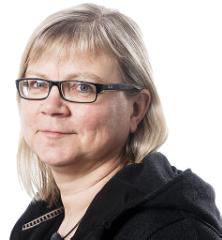 |
| Seija Tuulentie |
A full load of bus passengers piles out to the dark and cold night near Keflavik in Iceland. They seem to stand hours without doing anything. Around one o’clock they are packed back to the bus which then returns to Reykjavik. This would seem absurd if one doesn’t know that they are hunting the northern lights.
It is of course not true that they are not doing anything. A lot happens. When the northern lights appear, an Asian man proposes his girlfriend. And the Norwegian troops come to check what these people are doing. They also disturb the experience with the lights of their car.
The most common thing to do during these northern lights trips is to try to adjust cameras. People regret that they hadn’t read the manuals beforehand.
In addition to Reykjavik, I have participated northern lights trips this winter in Akureyri, Tromsö, Alta, Muonio and Rovaniemi. In volume, Reykjavik and Tromsö are the biggest. Every night at least ten big busses full of people depart from Reykjavik bus station and drive about 50 kilometers outside the city. In Tromsö, there are 26 companies that arrange northern lights trips.
The quality of the trips varies a lot. The worst version means just driving for hours in snowfall and then staying 20 minutes outside and then driving back.
From the point of view of Finnish Lapland, Tromsö is especially interesting. If I were a tourist entrepreneur in Kilpisjärvi, I’d take my part of its success. Now tourist companies from Tromsö drive to the surroundings of Kilpisjärvi. However, this could be done the other way round so that entrepreneurs from Kilpisjärvi go and take a group from Tromsö and then accommodate them for the night in a good northern lights place and then drive them back next day.
From my experience, I’d say that Finland is better in combining the experience to base camp and camp fire. However, according to my travelling companions, the combination of snow mobiles and northern lights does not work. The snow mobiles interfere with the lights experience.
The guides have to be admired because of their devotedness. For example, a male guide from Reykjavik calls himself Ziggy Stardust and dreams of going to Greenland where there is no light pollution. Even no-shows are mainly not problems for the guides. For example, in our trip in Rovaniemi the English guide was so enthusiastic that we also were quite exited though there was almost no possibility to see the lights.
According to Finnish Tourist Board, the northern lights and other celestial phenomena are the most important attractions for foreign tourists who plan to come to Finland. In Norway, there is a big boom in northern lights as well; my trips were a part of the research project financed by Norwegian Research Council.
I have to say that I myself was also somewhat bitten by the northern lights bug as I realized how important the lights are for people coming from afar. However, I rarely watch the sky in the evening since the lights are present at time when it is prime time in television… And in normal life the northern lights would not be a good explanation to come home around three o’clock in the morning.
Link to article in Lapin Kansa
Northern Lights Field Trip in Northern Norway and Finnish Lapland
This field trip started in Tromsø 5 March, continued to Alta 8 March before we went to Mounio 9 March and Rovaniemi 11 March 2014. The researchers involved were Gunnar Thor Jóhannesson, Katrin Anna Lund, Seija Tuulentie, Tiina Kivela, Nigel Morgan (Tromsø and Alta only) and Bente Heimtun.
In total we participated in 15 northern lights tours by minibus, coach and charter boat as well as with snow shoes and snow mobile. On six of the tours we saw the northern lights. In particular the first two evenings of the field work (in Tromsø) the shows were magnificent and lasted for an hour or so. On one of these trips we had to drive to Finland to see the lights. On successful evenings it was very easy to focus more on taking photos of the lights than actually watching them!
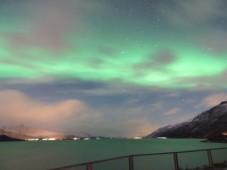 |
| Auora Borealis, tour from Tromsø. Photo: Gunnar Thor Jóhannesson |
As the field work continued the weather changed to the worse and in Alta we experienced the storm Jorun. This resulted in cancellation of one of the three trips this evening. However, on one of the tours they still managed to see Aurora Borealis as the storm stilled and the sky cleared. In Finnish Lapland the weather was sunny during the day and cloudy in the evenings, so our luck was over.
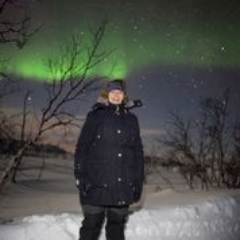 |
| Bente Heimtun in front of the northern Lights, tour from Tromsø to Finland. Photo: Florian Hansen, Arctic Guide Service |
In spite of no-shows, some of the tours were still nice as the guides were able to entertain and involve the guests. Then it was also pleasant to be outdoors watching the sky while waiting and to have the ability to seek shelter indoors. No-show trips involving a lot of driving, however, soon became tedious and boring.
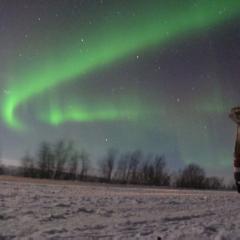 |
| Aurora Borealis, tour from Alta Photo: Gunnar Thor Jóhannesson |
In addition to participating in northern lights trips we also interviewed guides, this to get better insight into their relationships with and knowledge on Aurora Borealis as well as knowledge about different tourism markets and strategies for no-shows.
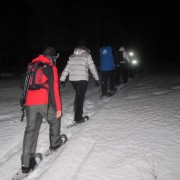 |
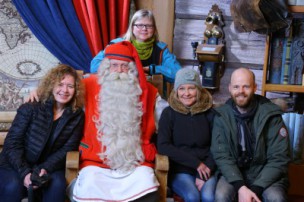 |
| Aurora Borealis picnic with snow shoes, tour in Rovaniemi Photo: Gunnar Thor Jóhannesson | Parts of the team meet Santa in Rovaniemi Photo: Santa Claus Village |
Conducting Data Collection on Soft and Hard Adventures
After a pilot survey conducted both in Lapland, Finland and in the Yellowstone National Park, United States a master student Sakari Hyytinen from the Multidimensional Tourism Institute, University of Lapland has travelled the main tourist destination in Finnish Lapland (Ylläs, Levi, Olos, Saariselkä, Pyhä-Luosto and Rovaniemi) to collect data on tourists’ opinions and experiences regarding guided nature tours. The data collection will be continued in Norway during the spring 2014.
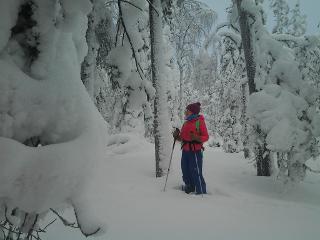 |
| Photo: Sakari Hyytinen |
The survey examines tourists’ opinions and experiences regarding the importance of learning, administration, group atmosphere, soft and hard experiences, and convenience in guided nature tours. The tourists answering the survey have seen the study important since the nature in North is vulnerable and information regarding the nature is looked for.
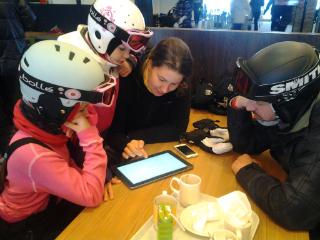 |
| Photo: Sakari Hyytinen |
Since the holiday time is precious for those who have travelled from far away, Sakari has utilized the moments of stopping for a coffee or hot chocolate to ask the tourists to answer for the electronic survey. The internet connections in the tourist centers have worked well and the joyful atmosphere has guaranteed a positive attitude towards the survey.
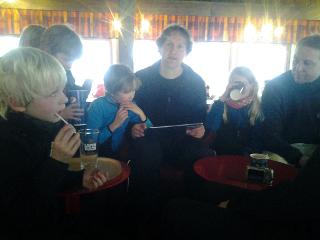 |
| Photo: Sakari Hyytinen |
We look forward for the primary results from the survey!
Outi Rantala (University of Lapland)
February 2014
Hunting The Lights With MS Midnatsol
24 – 26 February 2014 Bente Heimtun travelled with Hurtigruten from Tromsø to Kirkenes to increase her understanding of northern lights tourism in Northern Norway.
On board she was accompanied by some 500 tourists from Germany, France, Austria, UK, Brazil, Japan, and the Netherlands and so on. 90 of these tourists took part in the Astronomy Voyage organised by Hurtigruten in the UK, sold to an international market.
|
Heimtun spent two evenings on the ship, each night she went out about 21:30 to join the tourists searching for Aurora Borealis. In particular the second night they’re lucky and she stayed out for two hours. That night, after a public announcement, deck 9 was filled with tourists gazing at the sky and taking photos. Several of them used tripods to stabilise their cameras. The lights were a bit faded but the activity seemed high to a lay person like her.
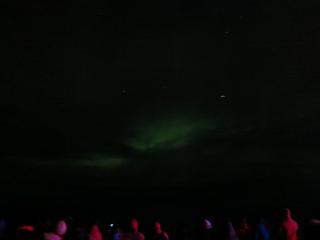 |
| A glimpse of Aurora Borealis from deck 9 (photo: Bente Heimtun) |
During the trip she also interviewed 19 tourists about their reason for taking this journey in the winter. Almost all of them were motivated by the Aurora, but also the chance of experiencing a winter climate and see winter landscapes. As the temperature was 5 C, several of them complained about the lack of coldness. For instance, they had not expected rain, as was the case in Tromsø.
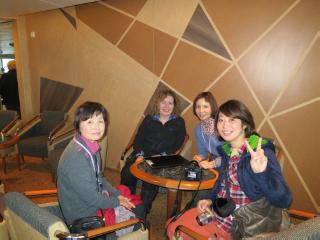 |
||
|
A Japanese family telling Bente Heimtun about their reasons for hunting the Northern Lights
|
Northern Lights Field Trip in Iceland
Gunnar Thor Johanesson, Katrin Anna Lund, Seija Tuulentie, Tiina Kivela and Bente Heimtun visited Iceland 8 – 13 February.
On the first night in Reykjavik we joined a four hour northern lights tour with Reykjavik Excursions. We boarded one of the eight buses that went out this evening at 21.00. Beside us, the bus was filled with English speaking tourists and some of Asian origin. After 40 min drive we stopped to search for the northern lights. And we were lucky, after some 30 min we had a very good show. We even experienced a marriage proposal and some geopolitical conflicts!
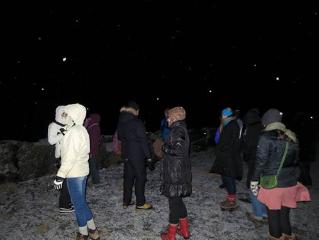
The next day we interviewed some northern lights tour guides before we on Monday flew to Akureyri, North Iceland to participate in two small scale tours with Saga Travel and to talk to some of their guides. On both nights we had no show. The weather was windy and snowy/rainy and the tours only lasted about two hours. On the first tour the guide tried to find the lights but was not successful. The group consisted of 14-15 tourists; most of them had been on a tour the previous day where they had seen some northern lights activity. They seemed satisfied with staying in the bus during most of the stop. The rest of us stayed outside, hoping for clear weather.
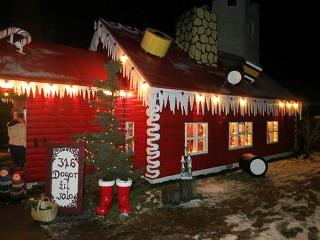
On the second night the northern lights tour was replaced with a visit to a Christmas house and a stop with a nice view on the city centre. On this tour we joined one US and one Japanese couple. On both tours the tourists seemed satisfied. They were informed about the low possibilities for northern lights spotting before the tours started. In a few weeks we continue collecting data in Tromsø/Alta and Muonio/Rovaniemi. Nigel Morgan will join us in Norway.
AVALANCHES AND RISK ASSESSEMENT
Article by Arild Røkenes in "Nordlys". Nb, only in norwegian.
April 2013
Field Trip Report, Data Collection with Master’s Students of University of Lapland
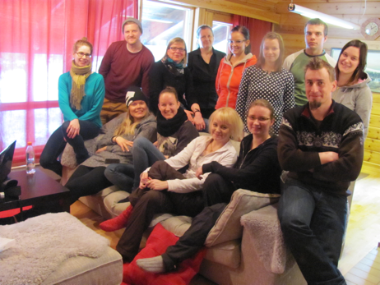 A four-day data collection trip for WP1 and WP4 was done in April 2013 by Marjo Kilpijärvi (University of Lapland) and Seija Tuulentie (Metla) with a group of 11 Master’s students in tourism research. The field trip was part of nature tourism field course. Students did interviews with nature tourism companies, guides and tourists in Ylläs, one ski resort in Finnish Lapland.
A four-day data collection trip for WP1 and WP4 was done in April 2013 by Marjo Kilpijärvi (University of Lapland) and Seija Tuulentie (Metla) with a group of 11 Master’s students in tourism research. The field trip was part of nature tourism field course. Students did interviews with nature tourism companies, guides and tourists in Ylläs, one ski resort in Finnish Lapland.
The group was divided in two. Those who worked on WP1 were interested in Arctic winter adventure tourism transformations, risks in relation to hard and soft adventures, and guides’ role in creating experience, guides’ training and skills, customers’ skills and expectations. The interviews showed that both tourists and guides have very subjective perspectives on what is adventure tourism and whether they participate in or provide adventurous experiences. Guide’s role in creating adventure experiences was considered to be highly important. It was commonly agreed that tourists nowadays do not know their limits, local conditions and risks. Snowshoeing was often mentioned as an activity that has become popular and that is usually considered as soft due to low level of skills needed and possibilities of experiencing nature. Interviewees were worried about this new trend because it involves more risks than expected. Avalanches, fatigue and cold weather can suddenly make it hard.
Themes of WP4 were related to the use of northern lights in the tourism of Ylläs and its surroundings. The interviews showed that northern lights are important but they are used in various ways. One of the accommodation providers emphasized northern lights experience but all what he does is to accommodate customers in surroundings that are suitable for seeing the northern lights. At the other end there were activity providers who really hunt the northern lights with the customers. If the northern lights were not present at their enterprise they arranged trips to other places where the customers could see the northern light. Thus, they almost guaranteed the northern lights experience. The students were also interested in the use of technology as part of the experience. All entrepreneurs did give some guidance e.g. to photographing the phenomenon.
All the students were interested in the research topics and enjoyed doing interviews. We had really useful and lively discussions during those days, and we all think that this was an excellent start for the project. It was helpful to do some research at this stage to start understanding our aims and to get some context for our discussions.
Marjo Kilpijärvi (University of Lapland) and Seija Tuulentie (Metla).
The Finnish Research Team (Photo: Maarit Mäkelä)
August 2013
Winter holidays in Northern Norway – for Special Interest Tourists?
Preliminary findings from the research project “Motivation – winter tourists” (WP1) indicate that the destination is for those who appreciate a cold winter climate, activities such as skiing and dog sledging, and the Northern Lights. There seems to be a general lack of knowledge about the area, except among those who have a particular interest in the North.
10-16 July 2013, Assoc. Prof. Bente Heimtun, UiT and Master Student Hanne Syverstuen asked 116 domestic and international tourists, visiting Vigelandsparken in Oslo, if they would like a winter holiday in Northern Norway and their reasons why (not).
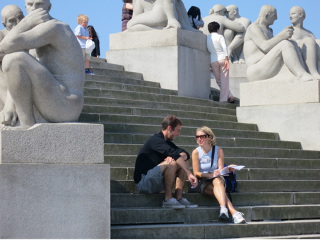 |
|
||
| Hanne Syverstuen at work. (Photo: Bente Heimtun) |
